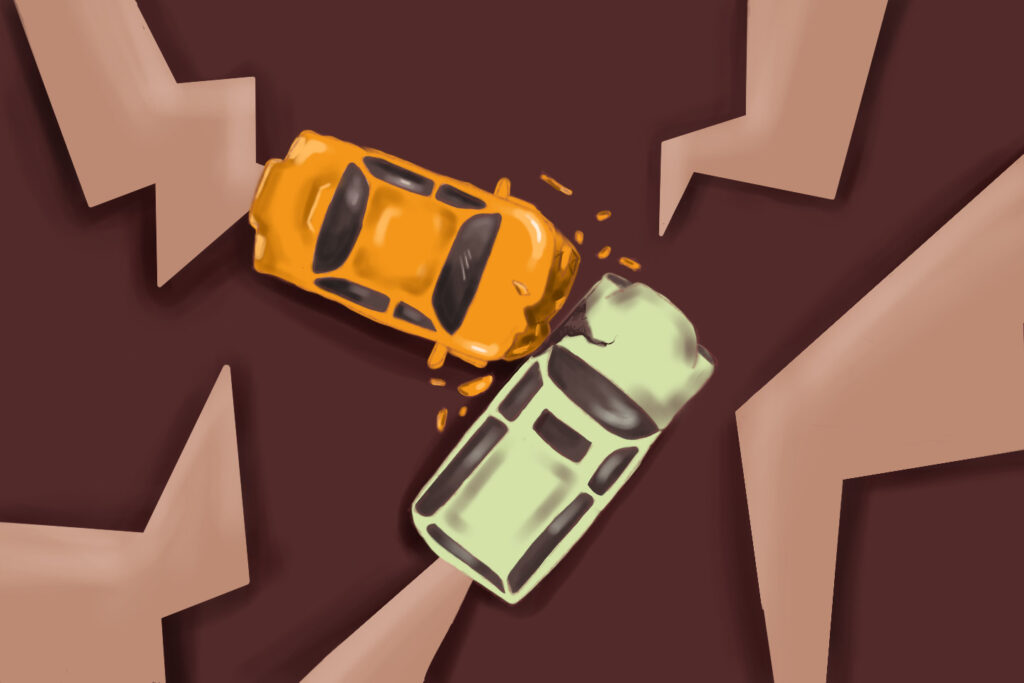Crashing
words by Romina Emtyazi
illustration by Faith Dong
Whenever someone asks me to think about the personal meaning of a word, I immediately assume that I need to come up with some remote, allusive, or metaphorical definition. But when it comes to disaster, the only idea that comes to my mind is its most redundant and conventional meaning. It involves physical pain, blazing objects flying around, and mainly, an utter loss of control.
I don’t remember much of that day. I recall being so exhausted from school that I decided to go to my sister’s place for the night rather than stay at my dorm. I was on the subway and going through snapchats that friends had sent me. I glossed over hers without batting an eye: a video of her with friends in a car, laughing and singing along to music—merely moments before disaster.
About three years before that, I had designated a specific day to say goodbye to her; we met at a coffee shop around noon and ended up strolling in the street until seven o’clock. On that day, I assured her that I was going to come back in less than a year, and I was optimistic that perhaps at some point, she would come to Toronto, and I could show her around the city. But after moving to Canada, I hadn’t been able to visit home. As disappointing as the situation was, it wasn’t a huge bother to me. I knew that there would be plenty of other opportunities for me to go back and see her. Plus, I managed to keep in touch with her frequently. Sometimes our conversations only went as far as a short courtesy call; but at other times, they would span into hour-long FaceTime calls, which always ended with us concluding that we were in no place to judge the people we had just spent hours discussing.
That’s the thing about disasters: their defining trait is their unpredictability. And that is what gives it a destructive power that throws your entire world into turmoil, with the ensuing grief creasing your life in such a way that it becomes unavoidable. So, the day that I found out had initially seemed like any other day to me. I went to bed the night before around midnight, and my phone lit up with three voice messages from one of my old school friends. I assumed that she had just texted to update me about some petty drama that was happening at the time, so I ignored it and went to bed. I woke up the next morning scrolling through Instagram stories—all covered with beautiful photos of her, in monochrome.
I initially did not know how to react. I simply stayed in bed, viewing people’s posts and reading eulogies. In my own world at that time, everything felt strangely calm, as if I had never known this person who just passed away in a horrific accident. Finally, I got out of bed, ironed my clothes, and even managed to put some makeup on before going to class. My own impassive response to the situation was an additional fright that I was enduring in my head, but I simply didn’t know how to act. Looking back now, I understand that the peculiar moment of limbo was the initial shock.
But as the numbness subsides and grief evolves, the aftershocks persist. For a week following the accident, I would stare at her contact info on my phone. I would re-read our texts and re-watch all the videos we had taken together. However, that was not the worst part. The greatest pain was not the sudden disappearance of her name from my phone screen or the end of those FaceTime calls, but rather the knowledge that this aftermath is permanent. With natural disasters like an earthquake, aftershocks tend to be the most destructive, as they destroy what has already been extremely weakened by the initial shock. The aftershock is what causes a previously-damaged building to collapse—it can never be rebuilt identically to its original state.
Disaster does not require an other-worldly interpretation to be defined or understood. It picks its victims at random and fills our lives with voids that serve as constant reminders of its tyranny. And while disaster may not necessarily build up strength or resilience, it does provide a transformed state of equilibrium wherein we manage to coexist with our bereavement.

